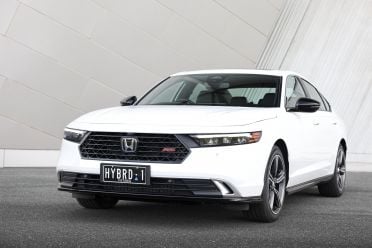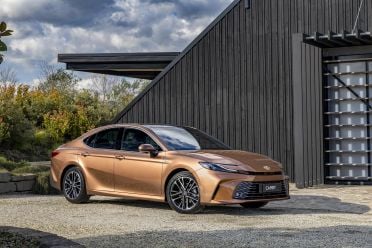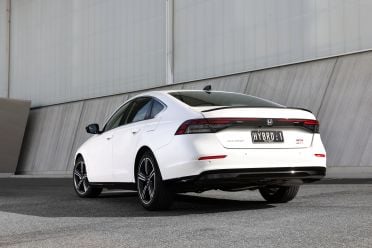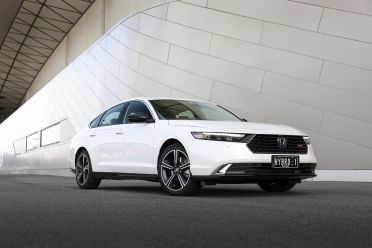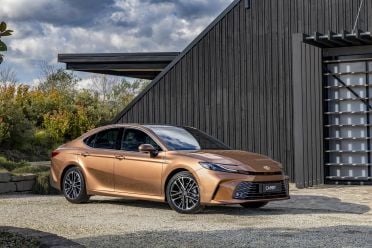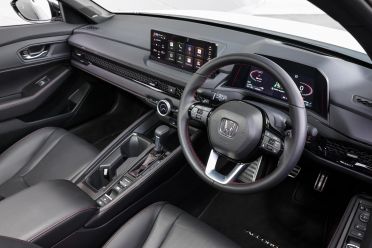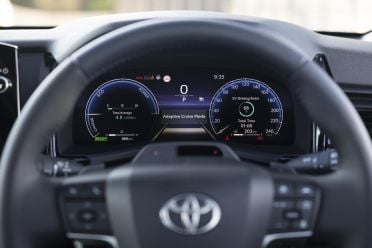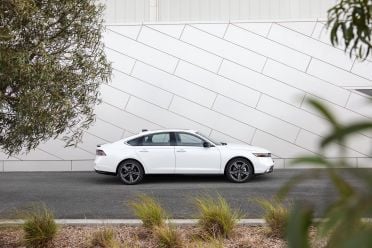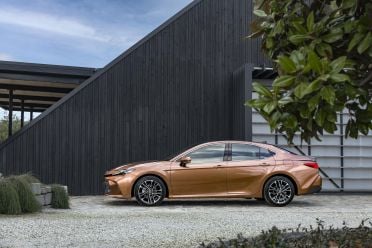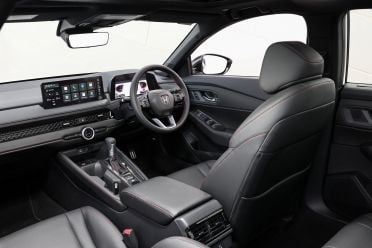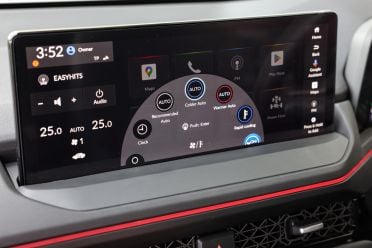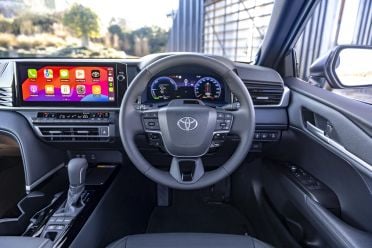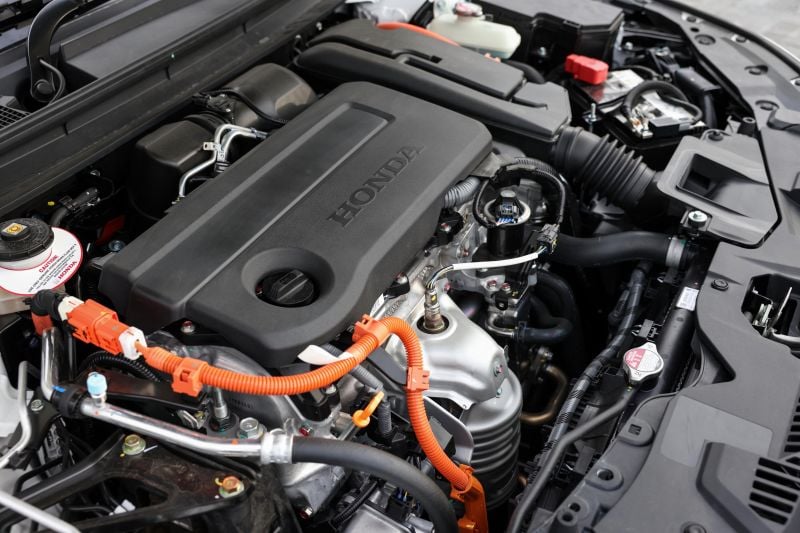The traditional family car has changed a lot over the last 20 years.
Today, SUVs have taken over from conventional three-box sedans as the default option for Australian new car consumers.
Consequently – and even long after the demise of keystone vehicles like the Holden Commodore and Ford Falcon – the choice of mainstream mid-size passenger sedans has diminished dramatically. Only a few legacy models remain, such as the Honda Accord and Toyota Camry we’re comparing here.
And even then, these two are playing in a different league to their predecessors by attempting to lure empty-nesters away from luxury brands, rather than attracting budget-conscious families.
How well do they do that, and which one is the most attractive proposition? Well, let’s find out.
How much?
The Honda Accord has been a mainstay for the Japanese brand since it first arrived in 1977. Now in its 11th-generation, it acts as the company’s flagship model with a single variant – the fully-loaded, hybrid-only e:HEV RS that commands an eye-watering $64,900 drive-away pricetag.
The Toyota Camry, on the other hand, is more accessible with a three-variant lineup that starts at $39,990 (plus on-road costs) for the entry-level Ascent, with the mid-range Ascent Sport asking $3000 more.
The range-topping SL that we’re comparing here against the Accord RS is priced from $53,990 plus on-roads.
The price gap closes considerably when taking into account the additional statutory charges, but the Camry still comes out in front by around $5000.
What do you get?
As far as on-paper specifications are concerned, both the Accord RS and Camry SL are loaded with a lot of standard equipment. And there’s not much to separate them.
They both ride on 18-inch alloy wheels, have LED headlights, panoramic sunroofs and keyless entry, while their cabins are cloaked in leather trim and feature twin digital screens, power-adjustable front seats, head-up displays, and dual-zone climate control with rear vents.
The Camry has two 12.3-inch units for the instrument cluster and infotainment system, while the screen in front of the driver in the Accord is slightly smaller at 10.2 inches.
Both have wireless smartphone mirroring and Bluetooth connectivity, as well as multiple USB power outlets, embedded satellite navigation, DAB+ digital radio and wireless phone chargers. But the Accord has integrated Google Maps, Google Assistant and Google Play, and a 12-speaker Bose audio system , while the Camry’s JBL system has nine speakers.
The Honda uses the audio system to reduce unwanted exterior noises via Active Noise Control technology, and has adjustable multi-coloured ambient interior lighting.
Are they safe?
The Toyota Camry has a maximum five-star ANCAP rating under the latest (2024) testing protocols, whereas the Accord has yet to be assessed by the independent safety authority.
However, both are equipped with a comprehensive array of advanced safety systems that includes:
- Autonomous Emergency Braking (AEB)
- Adaptive Cruise Control
- Blind spot warning
- Lane departure warning
- Lane keeping assistance
- Traffic sign recognition
- Driver monitoring
- Front and rear parking sensors
- Eight airbags
- Automatic high-beam
- Reverse camera
- Rain-sensing wipers
- Head-up display
The only minor variations are that the Camry has a digital rear-view mirror, while the Accord has a 360-degree parking camera.
What are they like inside?
In terms of the space they take up on the road, the Accord and Camry have an almost identical footprint.
The Honda is fractionally longer, wider and taller – and also has a little extra between the front and rear axles – but we’re talking millimetre differences here.
What that equates to inside the cabin is that both have generous amounts of interior space with excellent headroom for all, and enough room for three across the rear bench.
The Accord has more cargo space in the boot than the Camry (570 litres compared to 524L), but both provide enough room to handle the weekly duties of a full family, as well as holiday getaways.
| Dimensions | Honda Accord e:HEV RS | Toyota Camry SL |
|---|---|---|
| Length | 4975mm | 4920mm |
| Width | 1862mm | 1840mm |
| Height | 1449mm | 1445mm |
| Wheelbase | 2830mm | 2825mm |
| Cargo capacity | 570L | 524L |
The Honda looks and feels a little more modern in its design with the central touchscreen placed like a tablet on the top of the dash, whereas the Camry’s is integrated into the sweeping air vents which looks a bit bulkier.
It also has some nice touches like the digital display in the centre rotary controller, which can show a myriad of functions including the time, temperature controls and current audio output, and there’s a cross-hatched pattern across the air vents that divides the dashboard.
There’s two large cupholders in the centre console and a large tray with a wireless phone charger at the base of the dash, a covered bin between the seats and deep door pockets large enough for water bottles.
The front seats are super comfortable and offer plenty of adjustment, and all the touch points are nice and tactile with high quality materials.
The Camry looks and feels a little more dressed-up than the Accord and, therefore, can’t hide its entry-level roots as well with cheaper plastics covering the dash and door cards.
But even still, it is a genuinely nice place to be, with front seats that are equally supple and offer slightly more lateral support, plus heating and ventilation, which is a noticeable omission from the Accord, especially considering its price premium.
What’s under the bonnet?
On face value, there are a lot of similarities about what powers the Accord and Camry. Both have a lean-burning petrol engine assisted by an electric motor (or two in the case of the Accord), which drive the front wheels through a continuously variable automatic transmission (CVT).
| Specifications | Honda Accord e:HEV RS | Toyota Camry SL |
|---|---|---|
| Engine | 2.0-litre 4-cyl petrol/electric hybrid | 2.5-litre 4-cyl petrol/electric hybrid |
| Engine outputs | 108kW | 138kW |
| Electric motor outputs | 135kW | 100kW |
| System outputs | 152kW / 335Nm | 170kW / NA |
| Battery | 1.04kWh | 4Ahr |
| Transmission | CVT automatic | CVT automatic |
| Drive type | Front-wheel drive | Front-wheel rive |
| Weight | 1609kg | 1625kg |
| 0-100km/h (claimed) | N/A | 7.2 seconds |
| Fuel economy (claimed) | 4.3L/100km | 4.0L/100km |
| Fuel tank capacity | 48L | 50L |
| Fuel requirement | 91-octane standard unleaded | 95-octane premium unleaded |
| CO2 emissions | 98g/km | 91g/km |
| Braked tow capacity | N/A | 400kg |
However, they do act slightly different in the way each of them combines the two propulsion sources.
The Camry, for starters, has a larger-capacity four-cylinder petrol engine that produces 138kW of power and 221Nm of torque, plus a single electric motor linked to the gearbox that provides an additional 100kW and 208Nm of assistance, powered by a 4Ahr lithium-ion battery pack mounted behind the rear seats.
This is a conventional parallel hybrid system in that the electric motor is only used on its own when moving away from a standstill, and then assists the petrol engine when on the move.
The net result is a combined maximum power output of 170kW (Toyota does not provide a claimed maximum torque figure) and remarkable combined fuel consumption of just 4.0L/100km.
The Honda, on the other hand, is a little more advanced. It has two electric motors sandwiched within its CVT transmission, a generator that primarily recharges the battery through regenerative braking, and a traction motor that helps the smaller-capacity 2.0-litre petrol engine that produces 108kW and 182Nm.
However, both electric motors can work together under acceleration and the petrol engine can be completely decoupled from the drivetrain when cruising, almost reversing the relationship between the two compared to the Camry.
This means the Accord can drive more often – and at any speed – on battery power alone.
Yet, despite its slight weight advantage, at 4.3L/100km the Accord can’t beat the Camry’s claimed fuel consumption, although it is tuned to use cheaper standard unleaded (91RON) petrol, where Toyota recommends a minimum 95RON Premium for the Camry.
Cost of ownership
Toyota and Honda are renowned for their long-term reliability, and both Japanese brands provide aftersales coverage for five years or unlimited kilometres. Both offer extensions if the vehicle is maintained according to the prescribed service schedule within their authorised dealer networks; Honda for an extra three years and Toyota for two, but only for the engine.
They also provide free roadside assistance (up to eight years at Honda and seven years at Toyota) and are among the most affordable to maintain through capped price servicing schemes. The Accord costs just $199 each year for the first five years, while the Camry is fractionally pricier to service at $255 annually over the same time period.
CarExpert’s Pick
It’s bewildering that these two sedans aren’t more popular because, for all the car things they do, they are bloody brilliant.
Both are exceptionally nice to drive thanks to a comfortable ride and sure-footed on-road dynamics, and both have genuinely spacious back seats, luxurious appointments and the latest in safety and convenience tech.
But more than anything, they are remarkably efficient for such large cars, especially compared to their mid-size SUV equivalents, which are more expensive to own.
Really, the only thing that separates them is their price tags, and in that regard the Camry comes out slightly ahead of the Accord.

